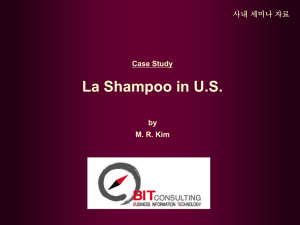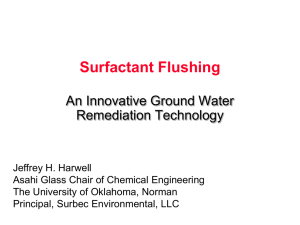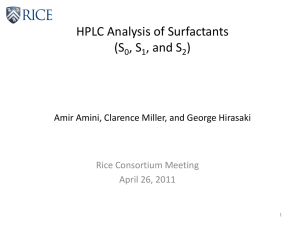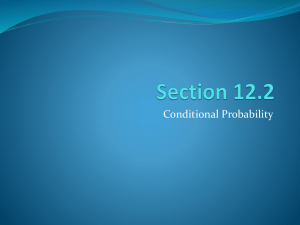Lesson1-Shampoo
advertisement
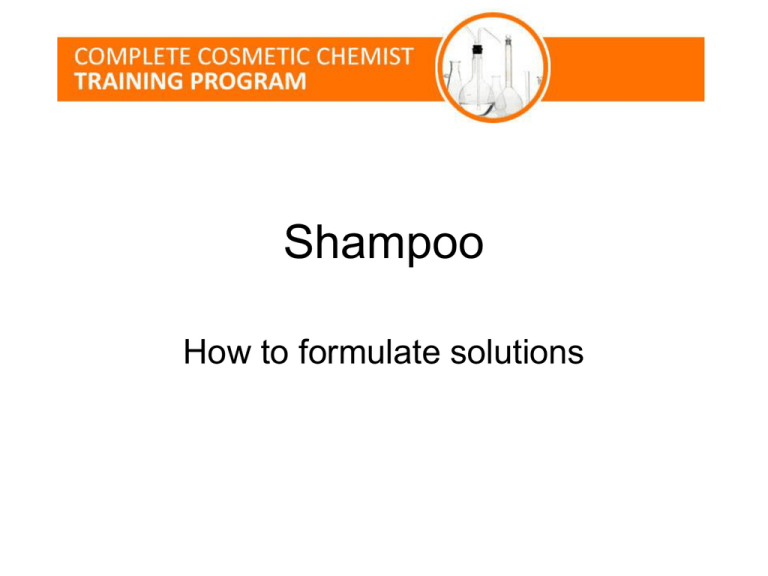
Shampoo How to formulate solutions Lesson Topics • • • • • Shampoo Market Overview Consumer Problems Surfactant Science Formulating a shampoo Testing Lesson Objectives • Shampoo Market Overview – Introduce the shampoo market • Consumer Problems – Explain the problems shampoo formulas are designed to fix • Surfactant Science – Discuss surfactant properties – How they are relevant to cosmetics • Formulating a solution – Dissect a shampoo formula – Explaining what ingredients are used and why • Testing – Explain how to test a shampoo Shampoo Shampoos • Solution cosmetic designed to clean hair and leave it a more manageable state • Solutions - one of the simplest types of cosmetic formulas Shampoo Market • Overall Market – Hair care market estimated ~ $40 Billion worldwide – Amount of money spent in US on Shampoo/conditioner • $2.26 billion (Food, Drug, Mass market)* *Does not include Walmart US Top Brands BRAND $ MARKET SHARE • • • • • • • • • • • • • • • • • • • • • • Pantene – P&G Head & Shoulders – P&G Herbal Essences – P&G Suave - Unilever Garnier (Fructis) – L’Oreal Tresemme – Alberto Culver Matrix (Biolage) – L’Oreal L'Oreal (Vives) – L’Oreal Dove - Unilever Private Label John Frieda - Kao *Data from IRI covering 52 weeks ending 5/2009 16 7.6 7.5 6.9 6.6 4.0 3.9 3.8 3.3 3.3 3.2 US Top Brands BRAND Units sold (millions) • • • • • • • • • • • • • • • • Suave - Unilever Pantene – P&G VO5 – Alberto Culver Herbal Essences – P&G Garnier (Fructis) – L’Oreal Head & Shoulders – P&G L'Oreal (Vives) – L’Oreal Tresemme – Alberto Culver *Data from IRI covering 52 weeks ending 5/2009 20.9 19.5 11.8 11.5 10.6 7.5 5.4 5.2 Shampoo Market • Types of shampoo (marketing) – – – – – – – – – – Normal Extra body (volumizing, thickening, etc) Moisturizing (smoothing, shine, restore) Strengthening Curl 2 in 1 Color treated Color Enhancing Baby (tear-free) Natural Shampoo Market • Specialty – Anti-dandruff – Anti-lice – Hair loss treatments • Significantly Different – Powdered shampoos – No-rinse shampoo – Co-washing Consumer Problems • • • • • • • Clean hair / oil removal Moisturize Easier to comb Prevent frizz Shine Volume Medicated – Anti-dandruff – Anti-lice – Hair loss Addressing the problems Problem • Clean hair / oil removal • Moisturize • Easier to comb • Prevent frizz • Shine • Volume • Medicated – Anti-dandruff – Anti-lice – Hair loss Technology • Surfactants • Conditioning agents – Anti-dandruff agents – Acaracides – Minoxidyl Surfactant Science Surfactants • Defined – Molecules compatible with water & oil – Surfactant = Surface Active Agent Surfactant Molecule Hydrophilic = Lipophobic Hydrophobic = Lipophilic Surfactant in solution • Reduces surface tension • Helps disperse oil in water (or water in oil) • Forms micelles to suspend particles Surfactant • Typical surfactant mixture – Surfactant is mixed with oil – Lipophilic tails orient with oil – Polar heads orient with water – Micelles are created • Micelle formation • Critical Micelle Concentration Surfactant Solutions • Depending on concentration different structures are formed • Simple shampoos are basically surfactant solutions (no oils) Surfactant Structures Surfactant Functions • Key in Shampoos – – – – – – Cleaning / Detergency Wetting Dispersing Foaming Thickening Conditioning • Other functions – – – – – Emulsification Solubilization Penetration enhancement Antimicrobial activity Opacification Detergency • Two types of “dirt” in hair – Solid particulate – Oily deposits • Solid particulates – From pollution, hair products – Adhere via Van der Waals forces – Anionics & non-ionics increase hydrophylicity of surface Detergency • How surfactants remove liquids – Remove dirt & grease from surfaces – Mechanism • Surfactant orients along oil/water interface • This lifts oil off surface suspending in solution • Rinse water removes the oil micelle Wetting • Breaks down the inherent surface tension of water • Water with surfactant can spread better on the hair Without Surfactant With Surfactant Dispersing • Particles are suspended in the shampoo / water solution • They are removed upon rinsing Foaming • Air is dispersed in a continuous liquid medium • Air bubbles are surrounded by thin layers of liquid films • Foam doesn’t contribute much to removal of dirt – Consumers like foam but it doesn’t really mean the product cleans better Thickening • Viscosity of surfactant solution can be affected by – Concentration of surfactant – Salt concentration – pH Types of Surfactants • Anionic – Negatively charged • Amphoteric (Zwitterionic) – capable of both positive & negative charges • Cationic – Positively charged • Nonionic – No charge Anionic Surfactants • These are the primary shampoo surfactants • Alkyl Sulfates – Examples - SLS • Alkyl Ether Sulfates – Example – ALES • Alpha – Olefin Sulfonates – Examples Anionic Surfactants • Other types – Sulfosuccinates – Alkylbenzene Sulfonates – Acyl Methyltaurates – Acyl Sarcosinates – Acyl Isethionates – Acyl Polypeptide Condensates – Monoglyceride Sulfates – Fatty Glyceryl Ether Sulfonates Anionics • Why use them? – Excellent detergency – Relatively inexpensive – Good foaming – Highly stable • Drawbacks – Can be irritating – Drying to hair Amphoteric Surfactants • Can have a positive or negative charge depending on the pH of the solution • Zwitterionic • Types – Cocamidopropyl Betaine – Cocoamphopropionate – Sodium Lauraminopropionate Amphoteric Surfactants • Why use them? – – – – Good Detergency Less Irritating than anionics Helps thicken system Helps improve foam • Drawbacks – More expensive – Do not foam well enough on their own Non Ionic Surfactants • Surfactant molecules with no charge • Types – Fatty Alkanolamides • Lauramide DEA • Cocamide DEA – Amine Oxides • Lauramine Oxide • Stearamine Oxide Non Ionic Surfactants • Why use them? – – – – – – – Foam enhancer Reduce irritation Increase viscosity Conditioning effect Anti-static effect Solubilize fragrances Baby Shampoos • PEG-80 Sorbitan Laurate • Drawbacks – Safety issues – More expensive – Do not foam well on their own Cationics • Positively charged surfactant molecules • Types – Cetrimonium Chloride – Stearylalkonium Chloride • Not used for shampoos – Don’t clean as well – Don’t rinse as well – Don’t foam as well Shampoo Formulations Shampoo Characteristics • Aesthetics – Appearance • Clear • Pearlized – Thickness (Viscosity) • Foam – Creamy, rich to thin & loose • Harshness • Conditioning effects Basic types of Shampoos • • • • • • Normal Volumizing Moisturizing 2 in 1 Baby Natural Shampoo Performance 10 9 8 7 6 5 4 3 2 1 0 Foam Quality Conditioning l at ur a N by Ba 1 in 2 ur iz in g M oi st dy Bo Ex tra or m al Harshness N Rating (10 best) Shampoo Type Comparison Shampoo Formula • • • • • • • • • Water Surfactant Secondary Surfactant Preservative Conditioning agent Color Fragrance Feature Ingredients Specialty ingredients Shampoo Formula • Secondary Surfactant – Modify viscosity – Improve foam – Reduce irritation • Aesthetic ingredients – Opacifying agent – Clarifying agents – Colorants Shampoo Formula • Conditioning agents – Silicones – Cationic polymers • • • • Preservatives Fragrance Feature Ingredients Formula Adjusters – Acid – Chelating agents Cosmetic Formula sheet Normal Shampoo Formula Activity of Ingredients • Many raw materials are sold diluted • % Solids = Raw material – water • Eg. ALS sold as 28% solids • 32% of the supplied raw material is only ~9% solid ALS • % Active is usually synonymous with % Solids Volumizing Shampoo Formula Volumizing Shampoo • Higher level of surfactant • Volumizing polymer (optional) – Guar hydroxypropyltrimonium chloride Moisturizing Shampoo Formula Moisturizing Shampoo • More gentle detergents • Added conditioning ingredients – Polyquaternium-7 – Dimethicone Copolyol • Pearlized – (optional) – Glycol Stearate 2-in-1 Shampoo Formula 2 in 1 Shampoo • Added conditioning ingredients – Dimethicone – Polyquaternium-10 • Pearlized – Glycol Stearate • Stabilizing agent (optional) – Carbomer Baby Shampoo Formula Baby Shampoo • More mild detergent system • Compromise qualities for mildness – Foam – Detergency – Conditioning • Minimize fragrance Natural Shampoo Formula Natural Shampoo • Sulfate free detergent • “Gentle” preservatives – No Parabens – No DMDM Hydantoin • Natural extract ingredients • Synthetic fragrance free? Making the batch Equipment • • • • • • • • Beakers Mixers Thermometer Stand Hot plate Scale Weigh boats Plastic wrap Formulating Equipment Shampoo Batching tips • Cover batch with plastic wrap • Record time, temp, changes • Pre-weigh ingredients • Weigh container prior to making batch – Compensate for water loss • Take specification readings at the end – Adjust as needed – Shampoo testing • QA/QC Tests • Performance Tests Shampoo testing • QA/QC Tests • Specifications – Viscosity – pH – Appearance – Odor Shampoo testing • Use Tests – Try product yourself – Panel testing Shampoo testing • Tress testing – Combing – Feel / Softness – Shine Shampoo testing • Foam testing – Blender – Shake test Shampoo testing • Safety testing – Patch testing – Irritation tests Shampoo Stability testing Shampoo Summary • Shampoo Market Overview – Big compared to other cosmetics • Consumer Problems – Cleansing, conditioning primary problems • Surfactant Science – Makes oil & water more compatible – Responsible for cleaning hair • Formulating shampoos – 6 types of shampoos • Testing – Use tests, lab tests, and QC tests Shampoos


